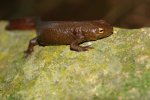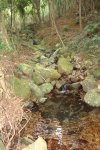See some pics of trips to Hongkong 2 years ago when I was lucky to meet wild newts.
The pictures were taken in Kadoorie Farm and Botanical Garden. This "organisation" was established in the 1950 to help farmers to practise substainable farming on the steep slopes of Hongkong Islands. Nowadays Kadoorie is doing a lot of public awareness in ecology and nature protection and actively helps to save the Hongkong fauna and flora. There is an exhibition area open for public for a fee but wild animals as the newts you will see only with the help of the staff because the natural forested parts of the area are closed for "normal visitors" and well guarded.
In a stream at the upper part of the hill I found some newts in September but none in June. I learned from Kadoorie guys (thanks to P. Crow) that newts are concentrated in stream pools after rain period in summer and reproduce from October to January. That prevents larvae from being washed away dowstreams during summer thunder storms and heavy rain in unsuitable parts were probably no shelter, food and a lot of enemies are (bigger fishes). The adults were observed by Kadoorie staff to walk on land during heavy rain, possibly to escape the flood wave (!?) and reaching other water bodies.
I could imagine the newts spend some time of the year, dry season and middle of rainy summer, on land near the streams but I do not have any evidence.
The newts I observed in pools 2m wide and 0.1 to 0.5m deep. I found no aquatic plants but fallen leaves (inbetween two females) and fine roots of trees what gave them shelter (one male). Stones and gravel of different sizes form the bottom of pools (one male). I found many different small crustaceans swimming around and feeding on rotting leaves in the water. The biggest fishes in these pools were 10cm long.
Water temperature 21°C in September. In dry season after January the stream can shrink nearly to zero.
The pictures were taken in Kadoorie Farm and Botanical Garden. This "organisation" was established in the 1950 to help farmers to practise substainable farming on the steep slopes of Hongkong Islands. Nowadays Kadoorie is doing a lot of public awareness in ecology and nature protection and actively helps to save the Hongkong fauna and flora. There is an exhibition area open for public for a fee but wild animals as the newts you will see only with the help of the staff because the natural forested parts of the area are closed for "normal visitors" and well guarded.
In a stream at the upper part of the hill I found some newts in September but none in June. I learned from Kadoorie guys (thanks to P. Crow) that newts are concentrated in stream pools after rain period in summer and reproduce from October to January. That prevents larvae from being washed away dowstreams during summer thunder storms and heavy rain in unsuitable parts were probably no shelter, food and a lot of enemies are (bigger fishes). The adults were observed by Kadoorie staff to walk on land during heavy rain, possibly to escape the flood wave (!?) and reaching other water bodies.
I could imagine the newts spend some time of the year, dry season and middle of rainy summer, on land near the streams but I do not have any evidence.
The newts I observed in pools 2m wide and 0.1 to 0.5m deep. I found no aquatic plants but fallen leaves (inbetween two females) and fine roots of trees what gave them shelter (one male). Stones and gravel of different sizes form the bottom of pools (one male). I found many different small crustaceans swimming around and feeding on rotting leaves in the water. The biggest fishes in these pools were 10cm long.
Water temperature 21°C in September. In dry season after January the stream can shrink nearly to zero.



